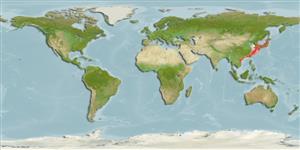>
Eupercaria/misc (Various families in series Eupercaria) >
Callanthiidae (Splendid perches)
Etymology: Callanthias: Greek, kalos, kallos = beautiful + Greek, anthias = a fish (Sparus aurata) (Ref. 45335).
Environment: milieu / climate zone / depth range / distribution range
Ecologie
marien benthopelagisch; diepte 70 - 200 m (Ref. 11230). Temperate
Northwest Pacific: southern Japan and East China Sea.
Grootte / Gewicht / Leeftijd
Maturity: Lm ? range ? - ? cm
Max length : 23.3 cm SL mannelijk / geslacht onbekend; (Ref. 110004)
Korte beschrijving
Determinatiesleutels | Morfologie | Morfometrie
Dorsale stekels (totaal) : 10; Dorsale zachte stralen (totaal) : 11 - 12; Anale stekels: 3; Anale zachte stralen: 10 - 11. Body color pink, ventrally yellow. Body elongate, compressed. Snout short, evenly rounded. Preoperculum rounded and smooth. Operculum with 2 spines. Attains 20 cm SL.
Occurs in sandy gravel or rock bottom (Ref. 11230).
Levenscyclus en paargedrag
Maturiteit | Voortplanting | Paaien | Eieren | Fecunditeit | Larven
Masuda, H. and G.R. Allen, 1993. Meeresfische der Welt - Groß-Indopazifische Region. Tetra Verlag, Herrenteich, Melle. 528 p. (Ref. 9137)
Status op de Rode Lijst van het IUCN (Ref. 130435: Version 2024-2)
Gevaar voor de mens
Harmless
Gebruik door de mens
Visserij: commercieel
Tools
Speciale rapporten
Download XML
Internetbronnen
Estimates based on models
Preferred temperature (Ref.
123201): 11.1 - 21.2, mean 18.4 °C (based on 109 cells).
Fylogenetische diversiteitsindex (Ref.
82804): PD
50 = 0.5039 [Uniqueness, from 0.5 = low to 2.0 = high].
Bayesian length-weight: a=0.00977 (0.00379 - 0.02521), b=3.08 (2.86 - 3.30), in cm total length, based on LWR estimates for this (Sub)family-body shape (Ref.
93245).
Trofisch niveau (Ref.
69278): 3.4 ±0.45 se; based on food items.
Fishing Vulnerability (Ref.
59153): Low vulnerability (18 of 100).
